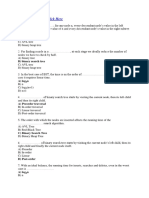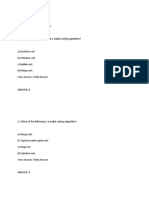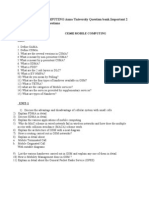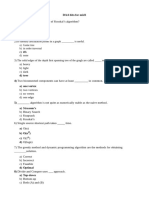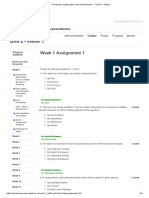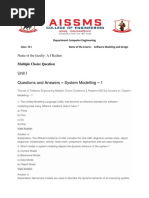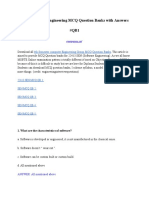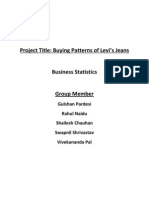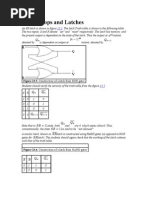Data Structures (DS) (Chapter - Non Linear Data Structures - Trees) Solved MCQs (Set-2)
Uploaded by
G H VamsiData Structures (DS) (Chapter - Non Linear Data Structures - Trees) Solved MCQs (Set-2)
Uploaded by
G H VamsiData Structures (DS) MCQs [set-2]
Chapter: Non Linear Data Structures - Trees
26. Find the postorder traversal of the binary tree shown below.
A. P Q R S T U V W X
B. W R S Q P V T U X
C. S W T Q X U V R P
D. none
Answer: C
27. For the tree below, write the in-order traversal.
A. 6, 2, 5, 7, 11, 2, 5, 9, 4
o m
B. 6, 5, 2, 11, 7, 4, 9, 5, 2
. c
C. 2, 7, 2, 6, 5, 11, 5, 9, 4
te
D. none
a
Answer: A
q M
28. For the tree below, write thec
level-order traversal.
M
A. 2, 7, 2, 6, 5, 11, 5, 9, 4
B. 2, 7, 5, 2, 11, 9, 6, 5, 4
C. 2, 5, 11, 6, 7, 4, 9, 5, 2
D. none
Answer: B
29. What is the space complexity of the in-order traversal in the recursive fashion?
(d is the tree depth and n is the number of nodes)
A. O(1)
B. O(nlogd)
C. O(logd)
D. O(d)
Answer: D
30. What is the time complexity of level order traversal?
A. O(1)
B. O(n)
C. O(logn)
D. O(nlogn)
Answer: B
31. Which of the following graph traversals closely imitates level order traversal of
a binary tree?
A. Depth First Search
B. Breadth First Search
C. Depth & Breadth First Search
D. Binary Search
Answer: B
32. In a binary search tree, which of the following traversals would print the
numbers in the ascending order?
A. Level-order traversal
B. Pre-order traversal
C. Post-order traversal
D. In-order traversal
Answer: D
33. The number of edges from the root to the node is called of the tree.
A. Height
B. Depth
C. Length
D. Width
Answer: B
34. The number of edges from the node to the deepest leaf is called of the tree.
A. Height
B. Depth
C. Length
D. Width
Answer: A
35. What is a full binary tree?
A. Each node has exactly zero or two children
Download more sets at McqMate.com
B. Each node has exactly two children
C. All the leaves are at the same level
D. Each node has exactly one or two children
Answer: A
36. What is a complete binary tree?
A. Each node has exactly zero or two children
B. A binary tree, which is completely filled, with the possible exception of the bottom level, which
is filled from right to left
C. A binary tree, which is completely filled, with the possible exception of the bottom level, which
is filled from left to right
D. A tree In which all nodes have degree 2
Answer: C
37. What is the average case time complexity for finding the height of the binary
tree?
A. h = O(loglogn)
B. h = O(nlogn)
C. h = O(n)
D. h = O(log n)
Answer: D
38. Which of the following is not an advantage of trees?
A. Hierarchical structure
B. Faster search
C. Router algorithms
D. Undo/Redo operations in a notepad
Answer: D
39. In a full binary tree if number of internal nodes is I, then number of leaves L
are?
A. L = 2*I
B. L = I + 1
C. L = I – 1
D. L = 2*I – 1
Answer: B
Download more sets at McqMate.com
40. In a full binary tree if number of internal nodes is I, then number of nodes N
are?
A. N = 2*I
B. N = I + 1
C. N = I – 1
D. N = 2*I + 1
Answer: D
41. In a full binary tree if there are L leaves, then total number of nodes N are?
A. N = 2*L
B. N = L + 1
C. N = L – 1
D. N = 2*L – 1
Answer: D
42. Which of the following is incorrect with respect to binary trees?
A. Let T be a binary tree. For every k ? 0, there are no more than 2k nodes in level k
B. Let T be a binary tree with ? levels. Then T has no more than 2? – 1 nodes
C. Let T be a binary tree with N nodes. Then the number of levels is at least ceil(log (N + 1))
D. Let T be a binary tree with N nodes. Then the number of levels is at least floor(log (N + 1))
Answer: D
43. Which of the following is false about a binary search tree?
A. The left child is always lesser than its parent
B. The right child is always greater than its parent
C. The left and right sub-trees should also be binary search trees
D. In order sequence gives decreasing order of elements
Answer: D
44. What is the speciality about the inorder traversal of a binary search tree?
A. It traverses in a non increasing order
B. It traverses in an increasing order
C. It traverses in a random fashion
D. It traverses based on priority of the node
Answer: B
45. What are the worst case and average case complexities of a binary search tree?
Download more sets at McqMate.com
A. O(n), O(n)
B. O(logn), O(logn)
C. O(logn), O(n)
D. O(n), O(logn)
Answer: D
46. What are the conditions for an optimal binary search tree and what is its
advantage?
A. The tree should not be modified and you should know how often the keys are accessed, it
improves the lookup cost
B. You should know the frequency of access of the keys, improves the lookup time
C. The tree can be modified and you should know the number of elements in the tree before
hand, it improves the deletion time
D. The tree should be just modified and improves the lookup time
Answer: A
47. Which of the following is not the self balancing binary search tree?
A. AVL Tree
B. 2-3-4 Tree
C. Red – Black Tree
D. Splay Tree
Answer: B
48. The binary tree sort implemented using a self – balancing binary search tree
takes time is worst case.
A. O(n log n)
B. O(n)
C. O(n2)
D. O(log n)
Answer: A
49. An AVL tree is a self – balancing binary search tree, in which the heights of the
two child sub trees of any node differ by
A. At least one
B. At most one
C. Two
D. At most two
Download more sets at McqMate.com
Answer: B
50. Associative arrays can be implemented using
A. B-tree
B. A doubly linked list
C. A single linked list
D. A self balancing binary search tree
Answer: D
Download more sets at McqMate.com
You might also like
- (Davis Et Al., 1992) Extrinsic and Intrinsic Motivation To Use Computers in The Workplace PDF50% (2)(Davis Et Al., 1992) Extrinsic and Intrinsic Motivation To Use Computers in The Workplace PDF22 pages
- Data Mining Classification: Alternative TechniquesNo ratings yetData Mining Classification: Alternative Techniques15 pages
- CS2402 MOBILE COMPUTING Anna University Question Bank0% (1)CS2402 MOBILE COMPUTING Anna University Question Bank6 pages
- Syllabus: Computer Architecture AND Parallel ProcessingNo ratings yetSyllabus: Computer Architecture AND Parallel Processing1 page
- TN TRB Polytechnic Lecturer CSE Answer Key100% (2)TN TRB Polytechnic Lecturer CSE Answer Key26 pages
- Important Question of Compiler Design (RGPV)No ratings yetImportant Question of Compiler Design (RGPV)2 pages
- CS2402 Mobile and Pervasive Computing SyllabusNo ratings yetCS2402 Mobile and Pervasive Computing Syllabus1 page
- @vtucode - in 21CS61 Module 5 PDF 2021 SchemeNo ratings yet@vtucode - in 21CS61 Module 5 PDF 2021 Scheme53 pages
- Text Processing: Data Structures and Algorithms in Java 1/47No ratings yetText Processing: Data Structures and Algorithms in Java 1/4747 pages
- A+b Ab+ A+b-C Abc-+ A+b C Abc + A+ (B C) Abc + (A+b) C Ab+c (A+b) (C-D) Ab+cd - A+b C-D Abc D-+ A+ (B C) - D Abc D-+No ratings yetA+b Ab+ A+b-C Abc-+ A+b C Abc + A+ (B C) Abc + (A+b) C Ab+c (A+b) (C-D) Ab+cd - A+b C-D Abc D-+ A+ (B C) - D Abc D-+12 pages
- Systems and Usable Security-Week-3 Assignment0% (1)Systems and Usable Security-Week-3 Assignment3 pages
- Construct The Binary Tree From Preorder and InorderNo ratings yetConstruct The Binary Tree From Preorder and Inorder2 pages
- Theory of Automata 20 Most Important QuestionsNo ratings yetTheory of Automata 20 Most Important Questions3 pages
- Compiler Mcqs Last Updated Solved CompleteNo ratings yetCompiler Mcqs Last Updated Solved Complete57 pages
- Project Title: Buying Patterns of Levi's JeansNo ratings yetProject Title: Buying Patterns of Levi's Jeans7 pages
- Superscalar Architectures: COMP375 Computer Architecture and OrganizationNo ratings yetSuperscalar Architectures: COMP375 Computer Architecture and Organization35 pages
- Programming in Arcgis Using Arcobjects and Aml: Guide 93No ratings yetProgramming in Arcgis Using Arcobjects and Aml: Guide 9326 pages
- Conceptual Foundation of CRM: Evolution of CRM Benefits of CRM Schools of Thought On CRM Different Definitions of CRMNo ratings yetConceptual Foundation of CRM: Evolution of CRM Benefits of CRM Schools of Thought On CRM Different Definitions of CRM39 pages
- Business Management Information Systems Take Home Final ExamNo ratings yetBusiness Management Information Systems Take Home Final Exam3 pages
- Numerical Solution To The Laplace EquationNo ratings yetNumerical Solution To The Laplace Equation8 pages
- ch6 - Simplification - of - CFGs - and - Normal - FormsNo ratings yetch6 - Simplification - of - CFGs - and - Normal - Forms32 pages
- Flip-Flops and Latches: Figure 13.3: Construction of A Latch From NOR GatesNo ratings yetFlip-Flops and Latches: Figure 13.3: Construction of A Latch From NOR Gates20 pages
- Bluetooth Smart Configuration Guide v31No ratings yetBluetooth Smart Configuration Guide v3130 pages
- (Davis Et Al., 1992) Extrinsic and Intrinsic Motivation To Use Computers in The Workplace PDF(Davis Et Al., 1992) Extrinsic and Intrinsic Motivation To Use Computers in The Workplace PDF
- Data Mining Classification: Alternative TechniquesData Mining Classification: Alternative Techniques
- CS2402 MOBILE COMPUTING Anna University Question BankCS2402 MOBILE COMPUTING Anna University Question Bank
- Syllabus: Computer Architecture AND Parallel ProcessingSyllabus: Computer Architecture AND Parallel Processing
- Text Processing: Data Structures and Algorithms in Java 1/47Text Processing: Data Structures and Algorithms in Java 1/47
- A+b Ab+ A+b-C Abc-+ A+b C Abc + A+ (B C) Abc + (A+b) C Ab+c (A+b) (C-D) Ab+cd - A+b C-D Abc D-+ A+ (B C) - D Abc D-+A+b Ab+ A+b-C Abc-+ A+b C Abc + A+ (B C) Abc + (A+b) C Ab+c (A+b) (C-D) Ab+cd - A+b C-D Abc D-+ A+ (B C) - D Abc D-+
- Construct The Binary Tree From Preorder and InorderConstruct The Binary Tree From Preorder and Inorder
- Superscalar Architectures: COMP375 Computer Architecture and OrganizationSuperscalar Architectures: COMP375 Computer Architecture and Organization
- Programming in Arcgis Using Arcobjects and Aml: Guide 93Programming in Arcgis Using Arcobjects and Aml: Guide 93
- Conceptual Foundation of CRM: Evolution of CRM Benefits of CRM Schools of Thought On CRM Different Definitions of CRMConceptual Foundation of CRM: Evolution of CRM Benefits of CRM Schools of Thought On CRM Different Definitions of CRM
- Business Management Information Systems Take Home Final ExamBusiness Management Information Systems Take Home Final Exam
- ch6 - Simplification - of - CFGs - and - Normal - Formsch6 - Simplification - of - CFGs - and - Normal - Forms
- Flip-Flops and Latches: Figure 13.3: Construction of A Latch From NOR GatesFlip-Flops and Latches: Figure 13.3: Construction of A Latch From NOR Gates








